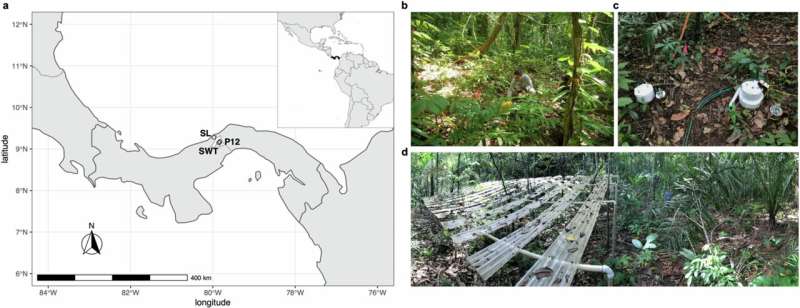By Anne M. Stark
Tropical forests account for more than 50% of the global terrestrial carbon sink, but climate change threatens to alter the carbon balance of these ecosystems.
New research by Lawrence Livermore National Laboratory (LLNL) scientists and colleagues from Colorado State University and the Smithsonian Tropical Research Institute has found that warming and drying of tropical forest soils may increase soil carbon vulnerability, by increasing degradation of older carbon. The research appears in Nature.
"These findings imply that both warming and drying, by accelerating the loss of older soil carbon or reducing the incorporation of fresh carbon inputs, will intensify soil carbon losses and negatively impact carbon storage in tropical forests under climate change," said LLNL scientist Karis McFarlane, lead author of the paper.
Tropical forests exchange more CO2 with the atmosphere than any other terrestrial biome and store nearly one-third of global soil carbon stocks. Tropical terrestrial ecosystems also have the shortest mean residence time for carbon on Earth, as short as 6-15 years, meaning that any change in carbon inputs or outputs (including CO2 emitted by soil) could have large and relatively rapid consequences for tropical ecosystem carbon balance and carbon-climate feedbacks.
Climate projections suggest a future that will be both warmer and drier for much of the tropics with increasing drought intensity and dry season length for the Neotropics (a region extending from southern Mexico through Central America and northern South America, including the vast Amazon rainforest).
The research, conducted during climate manipulation experiments in tropical forests in Panama, shows that both whole-profile in situ heating of soil by 4 °C and exclusion of 50% of rainfall increased carbon-14 in the CO2 released by the soil, increasing the average age of the carbon by the equivalent of ~2–3 years.

Importantly, the mechanisms underlying this shift differed between warming and drying. Warming accelerated decomposition of older carbon as increased CO2 emissions depleted newer carbon. Drying suppressed decomposition of newer carbon inputs and decreased soil CO2 emissions, thereby increasing the contributions of older carbon to CO2 release.
"Field and laboratory experiments suggest that climate warming will stimulate a net loss of global soil carbon to the atmosphere, but how climate warming and drying will interact to influence carbon balance in forests and other ecosystems is less clear," McFarlane said.
Most of the previous work in tropical forests only considered total CO2 flux rates, which are important for determining the overall carbon balance of tropical forests, but are limited in their ability to uncover mechanisms behind observed change. Those mechanisms can be revealed by carbon-14 values, which indicate the average age of the carbon sources being metabolized and released as CO2.
"New" or "young" carbon has been fixed from the atmosphere in the last few years while older "decadal aged" carbon is enriched in carbon-14 relative to the current atmosphere. Even older "century" or "millennial-aged" is depleted in carbon-14 relative to the current atmosphere.
In the current study, the team determined how warming and drying impact the amount and age of carbon released as soil CO2 in two distinct lowland tropical forest areas in Panama that are subject to experimental soil warming or experimental drying. They measured the carbon-14 and carbon-13 isotopes of soil-respired CO2.
Click here to see more...